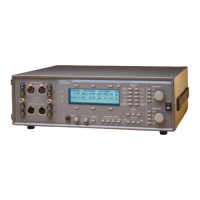To make a THD+N measurement, we begin by having the device create or reproduce a
single sinewave called the ‘fundamental tone’, which represents the desired sound.
Some of the unwanted sounds will also be created, so the frequency spectrum may look
like this:
The signal is measured with a voltmeter at this point. The measurement will be
dominated by the amplitude of the fundamental tone, since it is at a high amplitude
relative to the unwanted signals.
The signal is then run through a narrow bandreject filter to eliminate the fundamental
tone. The spectrum then looks like this:
The fundamental tone has been reduced to a level where it will be insignificant. The
filtered signal is then measured with another voltmeter, and the reading is presented as
a ratio of the two voltmeter readings.
Notice that the final measurement is ‘wideband’. It measures the total of all the noise
sources within the frequency range of interest. It is not specific to the frequency of the
fundamental tone. While some devices may create more or less harmonic distortion for
different fundamental frequencies, the other sources of unwanted sound will contribute
to the reading no matter what fundamental frequency is used.
Fundamental
Tone
Hum
Interference
Distortion
Noise
d
B
V
-140
20 20k50 100 200 500 1k 2k 5k 10k
Hz
+0
-120
-100
-80
-60
-40
-20
Figure 4-9. THD + N spectrum with fundamental
-140
+0
-120
-100
-80
-60
-40
-20
d
B
V
20 20k50 100 200 500 1k 2k 5k 10k
Hz
Fundamental
Tone Greatly
Reduced
Figure 4-10. THD + N spectrum with fundamental filtered
4 Functions
THD+N (Total Harmonic Distortion plus Noise) Function Descriptions
4-12 ATS-1 Dual Domain User's Manual

